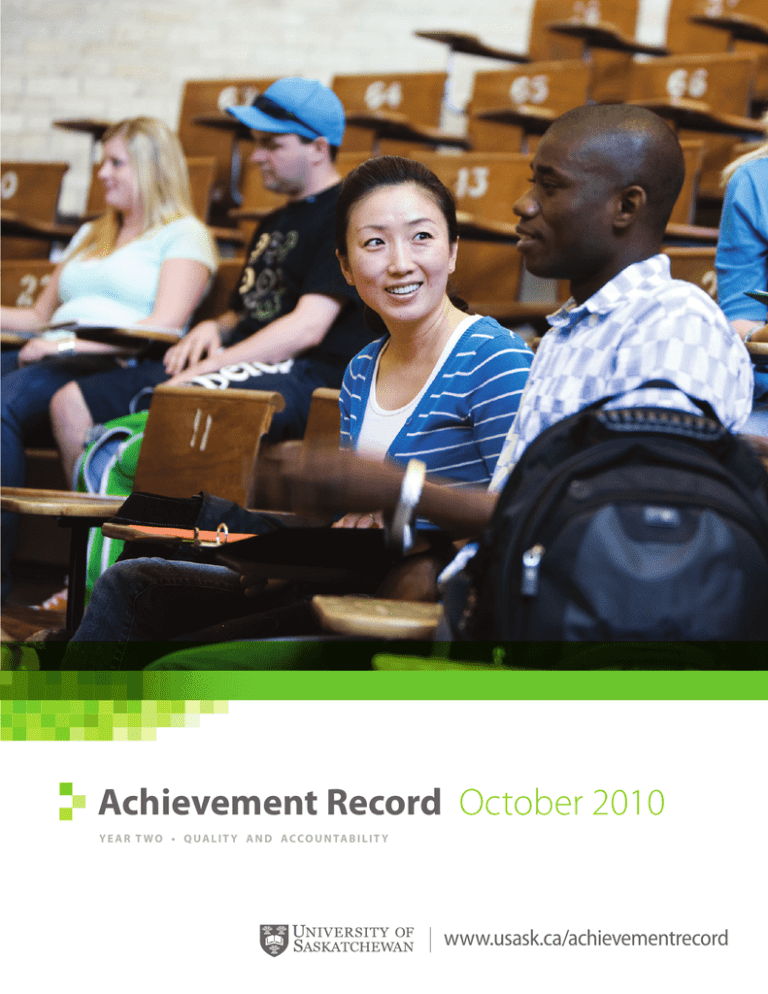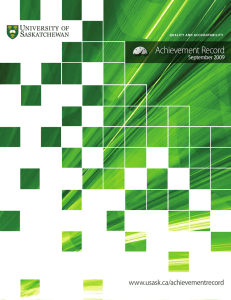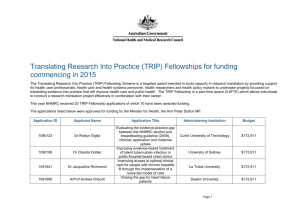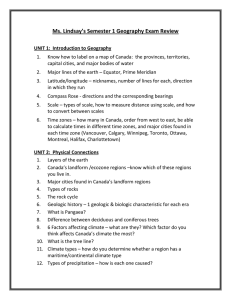Achievement record October 2010 www.usask.ca/achievementrecord
advertisement

Achievement Record October 2010 Y E A R T W O • Q U A L I T Y A N D A C C O U N TA B I L I T Y www.usask.ca/achievementrecord Achievement Record 1. Teaching, Learning and the Student Experience In order to gauge progress of the university’s strategic directions, and to adequately represent this progress to our community and the public at large, we have developed our second Achievement Record. We are committed to being accountable. We take responsibility for measuring and reporting the effectiveness of our work and using that information to continuously improve our performance. Benchmark Peer comparable data representing the norm or desired state. Target The goal or objective to be obtained by a specific date/time. 1.1 Students 1.3 Student Completion Rates Total number of undergraduate students in each year Percentage of first-time, full-time direct entry students who graduated within a six-year time frame Aboriginal International Other 1,833 708 15,026 1,753 782 15,062 1,597 780 14,896 1,638 852 14,955 Entry and final year of the six-year time frame shown on the graph Total number of graduate students in each year 1.4 Overall Satisfaction Percentage of students who responded favourably to questions about their overall quality of education/evaluation of their entire educational experience Aboriginal International Other 81 604 1,989 93 631 2,091 101 642 2,202 119 717 2,397 1.2 Instructional Activity Number of three credit unit equivalent registrations (3CUE) in each year 1.5 learning outcomes In progress – According to the University of Saskatchewan (U of S) Learning Charter, achieving the learning vision and goals to which we aspire requires the active commitment of students, instructors, and the institution. The U of S is working towards assessment tools for Learning Outcomes that will evaluate students’ knowledge of their discipline or profession, as well as their ability to apply critical and creative thinking to theoretical and practical problems. 2. Research, Scholarly and Artistic Work 2.1 External Funding for Research, Scholarly and Artistic Work Total and Tri-Agency Research Revenue 3. Working Together 3.1 faculty and staff engagement Percentage of U of S faculty and staff who responded favourably to questions about their level of engagement No survey was conducted in 2007 3.2 Administrative Efficiency Administrative Cost Ratio Administrative and general expenses as a percentage of total expenditures 2.2 Faculty Awards and Honours Number of prestigious awards received by U of S faculty based on national and international awards and honours over the four-year period 3.3 Diversified Revenues Monetary donations received by the U of S 2.3 output and impact In progress – An indicator for Output and Impact is currently under development working in close collaboration with the Office of the VicePresident Research. In June 2010, a symposium was held with colleges and units which focused in part on the need and process to develop research indicators on output and impact at an institutional college/unit level. A followup to this symposium is currently being planned for this academic year. 3.4 campus sustainability In progress – The Sustainability as a Shared Challenge commitment is reviewing benchmarking tools that may be used to measure our sustainability performance. From this review, a tool will be selected for the Campus Sustainability indicator for inclusion in a future Achievement Record. Q U A L I T Y A N D A C C O U N TA B I L I T Y www.usask.ca/achievementrecord 4. An Engaged University 4.1 Research Partnerships with External Partners Current number of: research partnerships with external partners; centres; existing articulation agreements; and experiential learning initiatives and internship programs 4.3 Aboriginal Community Aboriginal Student Success Number of self-identified Aboriginal students who have graduated in each calendar year Research Partnerships with External Partners Experiential Learning Initiatives and Internship Programs, Existing Articulation Agreements, and Centres Graduate Undergraduate 9 316 26 313 21 266 Aboriginal Faculty and Staff Percentage of faculty and staff who have declared Aboriginal ancestry 4.2 National Reputation Ranking of the U of S among 15 medical/doctoral institutions in Canada according to Maclean’s University Rankings IN PROGRESS We are working toward becoming an engaged university. Some of the indicators of our success require further development as part of our commitment to quality and accountability. University of Saskatchewan Achievement Record October 2010 Achievement Record Definitions and Sources 1. TEAC HING , LEA R NING AND THE S TUDENT EXPE R IEN C E Indicator Definition and Source 1.1 Students Represents registered students over a year. Total numbers are provided for all undergraduate, graduate, Aboriginal, and international students attending in the fall and winter term and/or the spring and summer term. Source: Student Information System 1.2 Instructional Activity Activity measured by the number of three credit unit equivalent registrations (3CUE) taken by students over a year. For a regular three credit unit class, one 3CUE is calculated for each student registered in that class. Source: Student Information System 1.3 Student Completion Rates Represents the cumulative percentage of first-time, full-time (at least 24 credit units of activity in first year) direct entry students who graduated from the U of S within a six-year time period. Source: Student Information System 1.4 Overall Satisfaction The percentage of U of S students who responded favourably to questions in various surveys about the overall quality of their education. The latest data is used for each survey. Source: National Survey of Student Engagement (NSSE), Canadian University Survey Consortium (CUSC), and Canadian Graduate and Professional Student Survey (CGPSS) 1.5 Learning Outcomes In progress 2 . R E S EA R C H , S C HOLA R LY AND A R TI S TI C WO R K 2.1 External Funding for Research, Scholarly and Artistic Work Represents total revenue restricted for research activity for a given fiscal year. The Tri-Agency funding component of total restricted research revenue is specifically identified and includes Natural Sciences and Engineering Research Council of Canada (NSERC), Social Science and Humanities Research Council of Canada (SSHRC), Canadian Institutes of Health Research (CIHR), and Networks of Centres of Excellence (NCE) in Tri-Agency Funding. Source: U of S Financial Statements and U of S Financial Systems 2.2 Faculty Awards and Honours The number of U of S faculty and staff who received prestigious awards based on a selection of national and international awards and honours over a four-year period. Awards and honours considered: 3M Teaching Fellowship, Canada Gairdner Wightman Award, Canadian Academy of Engineers Fellowship, Canadian Academy of Health Sciences Fellowship, E.W.R. Steacie Memorial Fellowship (NSERC), Killam Prize, Killam Research Fellowship, Molson Prize, NSERC Synergy Award for Innovation, Royal Society of Canada Fellowship, Tri-Council Highest Awards (NSERC Gerhard Herzberg Medal; SSHRC Gold Medal; CIHR Michael Smith Prize in Health Research), American Academy of Arts and Sciences, American Association for the Advancement of Science, Canada Gairdner International Award, Fulbright Award, Guggenheim Fellowship, National Academies (National Academy of Engineering; National Academy of Sciences; Institute of Medicine), National Humanities Center Fellowship, Sloan Research Fellowship, and Woodrow Wilson Fellowships and Scholars Program. Source: Office of the Vice-President Research 2.3 Output and Impact In progress 3. wo r k i n g to g e t h e r 3.1 Faculty and Staff Engagement The percentage of U of S faculty and staff who responded favourably to questions about engagement and development, diversity and the core values of the university. Source: U of S Employee Opinion Survey 3.2 Administrative Efficiency For a given fiscal year, the university’s administration and general expenses as a percentage of the University’s total consolidated expenses. Administration and general expenses at the U of S include all activities provided in direct support of instruction and non-sponsored research, including costs of central university administrative units and centralized units supporting academic and research programs. Source: U of S annual CAUBO return 3.3 Diversified Revenues Total dollars received by the U of S through donation over the course of each fiscal period (May 1 to April 30). Source: University Advancement report to the Board of Governors 3.4 Campus Sustainability In progress 4 . AN ENGAGED UNIVE R S ITY 4.1 Engagement Partnerships The number of (a) research partnerships with external partners (including research collaborators and funding agencies, international entities, equipment vendors, and licenses with external licensees); (b) designated centers that operate at various levels in the university structure; (c) existing articulation agreements; and (d) experiential learning initiatives and internship programs. Source: U of S Administrative Systems 4.2 National Reputation U of S national reputation ranking among the 15 medical/doctoral institutions in Canada. Source: Maclean’s University Rankings 4.3 Aboriginal Community Highlights aboriginal activity at the U of S including the number of self-declared Aboriginal graduates, faculty and staff. Source: Student and HR Information Systems Development of the U of S Achievement Record Institutions hold themselves accountable because they care about the quality and impact of what they do, and because they value their relationships with the public and with stake-holder groups. Accountability takes many forms, including annual reports, speeches and presentations by leaders, and meetings with interested communities. All forms of accountability must be backed by information that is clear, transparent, accessible, and that is presented with a minimum of commentary. It is essential to convey institutional achieve­ments widely, succinctly and based on evidence. The development of this Achievement Record is principle-based. o u r pr i n c i ple s AR E : 1. The Achievement Record should be widely discussed and collaboratively used. 2. The Achievement Record should support multiple purposes. 3. To serve its varied purposes, the Achievement Record should be simple. 4. Indicators ought to measure, as much as practical, the things that are meaningful or important to the organization. 5. Initially, the University of Saskatchewan should focus on a practical initial set of indicators, leaving more elaborate development for later if needed. Online Achievement Record The website www.usask.ca/achievementrecord is available to provide a richer view of the information contained within the printed version of the Achievement Record. Features on the website include: • explanation of the various targets and benchmarks used in the preparation of the Achievement Record • detailed breakdowns of the data used for each indicator • full data definitions and sources 144-10/OCT10/.3M • an opportunity to provide feedback www.usask.ca/achievementrecord








